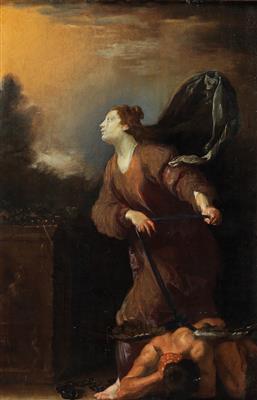Domenico Fetti

(Rome? 1588/9–1623 Venice)
Saint Juliana,
oil on panel, 62 x 40.3 cm, framed
Inscribed on the reverse: X Santa Ju/liana/Domenico Feti x/38/S. Margherita/1598.1674/Juliana,/Ginovesino,
Provenance:
possibly Viscounts Arconati, Villa Crivelli, Castellazzo, Lombardy;
sale, Il Ponte Casa d´Aste, Milan 16 April 2014, lot 174 (as Lombard-Veneto School);
where acquired by the present owner
The attribution of the present painting has been confirmed by Eduard Safarik (written communication, 24 March 2015).
The subject of Saint Juliana of Nicomedia was popular in seventeenth century Italy. As the patron saint of the sick and women in labour, she was venerated in many Italian shrines. She died around 305, martyred during the reign of the Roman Emperor Diocletian because she was accused by her father and her betrothed of converting to Christianity and refusing to renounce it. As we can see on the marble sarcophagus in the lower left of the present painting, she was beheaded.
The present composition was, it would appear, greatly appreciated by contemporary patrons and versions and copies of this work exist, including one in the Galleria Palatina, Florence (see Eduard A. Safarik, Fetti, Milan 1990, pp. 220-222, 224, catalogue no. 97a-97i). A version belonging to Niccolò Renieri (Regnier) in Venice is now in the Kunsthistorisches Museum, Vienna (see Safarik, ibidt., catalogue no. 97h).
Safarik believes that the prototype for this composition was originally in the Gonzaga collection, Mantua. A painting is mentioned in an inventory from 1627, drawn up following the death of Duke Ferdinando Gonzaga, in 1626. The inventory listed six paintings on wooden panels located in the hall “from the New Apartment built by Signor Duke Ferdinando under the clock towards Santa Barbara” (see R. Morselli, The Gonzaga Collection: list of goods from 1626-1627. [La Collezione Gonzaga. L’elenco dei beni del 1626-1627], Cinisello Balsamo, 2000, p. 322). These paintings were, according to Safarik, undoubtedly the work of Domenico Fetti, as was confirmed by the inventory of 1706, which was drawn up at the time of Duke Ferdinando Carlo Gonzaga, and which included the mention of one painting depicting “Virtue, which has tied up Vice [la virtu, ch’ha legato il vitio]”. The subject matter was, according to Safarik, incorrectly identified as Virtue.
Safarik notes that the present painting displays the decisive, strong brushstrokes typical of Domenico Fetti, and he has suggested that it may be unfinished in areas such as the robes of the saint. Safarik also observes that the head of the figure in the present painting is handled differently from other known versions.
25.04.2017 - 18:00
- Prezzo realizzato: **
-
EUR 43.180,-
- Stima:
-
EUR 40.000,- a EUR 60.000,-
Domenico Fetti
(Rome? 1588/9–1623 Venice)
Saint Juliana,
oil on panel, 62 x 40.3 cm, framed
Inscribed on the reverse: X Santa Ju/liana/Domenico Feti x/38/S. Margherita/1598.1674/Juliana,/Ginovesino,
Provenance:
possibly Viscounts Arconati, Villa Crivelli, Castellazzo, Lombardy;
sale, Il Ponte Casa d´Aste, Milan 16 April 2014, lot 174 (as Lombard-Veneto School);
where acquired by the present owner
The attribution of the present painting has been confirmed by Eduard Safarik (written communication, 24 March 2015).
The subject of Saint Juliana of Nicomedia was popular in seventeenth century Italy. As the patron saint of the sick and women in labour, she was venerated in many Italian shrines. She died around 305, martyred during the reign of the Roman Emperor Diocletian because she was accused by her father and her betrothed of converting to Christianity and refusing to renounce it. As we can see on the marble sarcophagus in the lower left of the present painting, she was beheaded.
The present composition was, it would appear, greatly appreciated by contemporary patrons and versions and copies of this work exist, including one in the Galleria Palatina, Florence (see Eduard A. Safarik, Fetti, Milan 1990, pp. 220-222, 224, catalogue no. 97a-97i). A version belonging to Niccolò Renieri (Regnier) in Venice is now in the Kunsthistorisches Museum, Vienna (see Safarik, ibidt., catalogue no. 97h).
Safarik believes that the prototype for this composition was originally in the Gonzaga collection, Mantua. A painting is mentioned in an inventory from 1627, drawn up following the death of Duke Ferdinando Gonzaga, in 1626. The inventory listed six paintings on wooden panels located in the hall “from the New Apartment built by Signor Duke Ferdinando under the clock towards Santa Barbara” (see R. Morselli, The Gonzaga Collection: list of goods from 1626-1627. [La Collezione Gonzaga. L’elenco dei beni del 1626-1627], Cinisello Balsamo, 2000, p. 322). These paintings were, according to Safarik, undoubtedly the work of Domenico Fetti, as was confirmed by the inventory of 1706, which was drawn up at the time of Duke Ferdinando Carlo Gonzaga, and which included the mention of one painting depicting “Virtue, which has tied up Vice [la virtu, ch’ha legato il vitio]”. The subject matter was, according to Safarik, incorrectly identified as Virtue.
Safarik notes that the present painting displays the decisive, strong brushstrokes typical of Domenico Fetti, and he has suggested that it may be unfinished in areas such as the robes of the saint. Safarik also observes that the head of the figure in the present painting is handled differently from other known versions.
|
Hotline dell'acquirente
lun-ven: 10.00 - 17.00
old.masters@dorotheum.at +43 1 515 60 403 |
| Asta: | Dipinti antichi |
| Tipo d'asta: | Asta in sala |
| Data: | 25.04.2017 - 18:00 |
| Luogo dell'asta: | Vienna | Palais Dorotheum |
| Esposizione: | 15.04. - 25.04.2017 |
** Prezzo d'acquisto comprensivo di tassa di vendita e IVA
Non è più possibile effettuare un ordine di acquisto su Internet. L'asta è in preparazione o è già stata eseguita.
